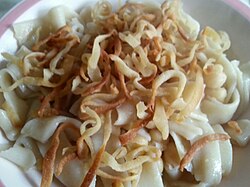Ciceri e tria
 | |
| Course | Primo (Italian pasta course) |
|---|---|
| Place of origin | Italy |
| Region or state | Salento |
| Main ingredients | Chickpeas, fried pasta |
Ciceri e tria (Italian: [ˈtʃiːtʃeri e tˈtriːa]) is a pasta dish originating in the Salento region. It is prepared with pasta and chickpeas as primary ingredients, and includes fried pasta. It has been described as a "classic and emblematic dish of Salentine cuisine"[1] and as a specialty dish of Apulia.[2]
Etymology[edit]
Ciceri means 'chickpeas' in Latin.[3] Tria, meaning 'pasta' or 'noodle', derives from an Arabic word for pasta, إطرية, iṭriyah (from the root طرو, ṭ-r-w, or طري, ṭ-r-y, 'to be fresh, moist, tender').[4] It means 'pasta' in the Genoese dialect.[5][3] Tria is the name for a local ribbon shaped pasta, much less known than orecchiette or cavatelli but equally treasured by the Pugliesi. Made from semolina flour and water, tria is often translated as 'tagliatelle', but they are actually quite different.[6][7]
Ingredients and preparation[edit]
Pasta and chickpeas are the primary ingredients in ciceri e tria.[1][3] Some versions of the dish may have a significant amount of broth, which may be eaten using a spoon.[1] Some of the pasta (from one-third to one-half) is fried in oil as part of its preparation, while the rest of it is boiled.[1][3] The use of fried pasta was originally performed to create a quality or mouthfeel of meatiness in the dish during times of meat scarcity.[1] The fried pasta may also add crunchiness to the dish.[1] Apulian versions may involve the chickpeas being simmered over a low heat while fresh pasta is being prepared.[3] Dried/uncooked chickpeas may be soaked one day prior to preparation of the dish.[3][5] Additional ingredients may include onion, carrot, celery and garlic.[3] It may be seasoned with black pepper.[3] It has been described as having a bacon-like flavor.[5] It may be served as a side dish with bread or rice.[1]
See also[edit]
![]() Ciceri e Tria at the Wikibooks Cookbook subproject
Ciceri e Tria at the Wikibooks Cookbook subproject
References[edit]
- ^ a b c d e f g Aggarwal 2013, pp. 136–137.
- ^ Anderson, p. 61.
- ^ a b c d e f g h Taylor 2013, pp. 108–110.
- ^ Lane, Edward William. Arabic-English Lexicon.
- ^ a b c Gade 2003, pp. 128–129.
- ^ Zanini De Vita 2009, pp. 302–303.
- ^ Aggarwal 2013, pp. 136-–137.
Sources[edit]
- Aggarwal, Uma (2013). America's Favorite Recipes, Part II: The Melting Pot Cuisine. iUniverse. ISBN 978-1475977868.
- Anderson, Burton. The Foods of Italy: An endless adventure in taste (5th ed.). Italian Trade Commission.
- Gade, H. W. (2003). The Digital Pasta Book 1 / Italian pasta. Vol. 1. NORDISC Music & Text. ISBN 8788619478.
- Taylor, John Martin (2013). The Fearless Frying Cookbook. Workman Publishing Company. ISBN 978-0761172000.
- Zanini De Vita, Oretta (2009). Encyclopedia of Pasta. University of California Press. p. 302. ISBN 978-0520944718.
Further reading[edit]
- Guaiti, Daniela (2010). Puglia (in Italian). Edizioni Gribaudo. p. 48. ISBN 978-8879068390.
